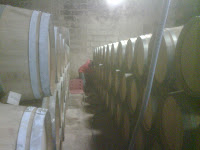I picked Libby up from Bergerac airport late afternoon and we headed straight for Navarra in Spain as tonight we are guests at Pagos de Cirsus hotel, winery and restaurant.
We arrived shortly after 9pm in Tuleda, Navarra after a 5 hour long drive from Bordeaux passing through Bayonne, St Sebastien and Pamplona. We finally turned into the valley where Pagos de Cirsus is situated and soon realised why there were no sign posts as you could see the huge magical castle tower illuminated miles away in the distance.

Approaching the castle was a like a Monty Python sketch as it seemed the more you drove towards it, the further away it became before suddenly popping up in front of us!
The long drive was soon forgotten as we were greeted by the friendly staff in the incredible hotel lobby – dominated by the extravagant staircase – and showed up to our magnificent room in the tower itself.
Pagos de Cirsus is owned by the Spanish film maker Iñaki Nuñez famous for producing films such as Basic Instinct and the hotel can boast some pretty impressive guests such as Jonny Depp and Sharon Stone. We freshened up and made our way down to the superb restaurant where we were greeted by Carlos, the funniest, maddest sommelier I have ever met! Followed by the equally talented and entertaining head chef Javier Luariz-Ayerdi.
We sat down and Javier came over and asked us what we would like eat, when I responded by saying “I will leave it in your hands” his eyes lit up and came alive with creativity! He instantly sat down at our table and flattened out a crumpled piece of paper upon which he scribbled out a personalised menu for us!
The 6 course menu included individual dishes of tempura prawns with orange, amazing white asparagus, local seasonal vegetables, wild mushrooms, hake fillet, and beef cheek ended with a local speciality dessert. Every dish was explained personally by the head Chef and matched superbly by the bull fighting-obsessed sommelier assigned to serve just our table, and with every wine served, a chest out matador stance followed! We tasted through a superb range of wines including:
Pago de Cirsus Chardonnay
Pago de Cirsus Chardonnay fermentado en barrica
Pago de Cirsus Cuve Especial
Pago de Cirsus Tempranillo
Pago de Cirsus Selección de familia
Pago de Cirsus Vendimia seleccionada
Pago de Cirsus Opus 11 selección
Pago de Cirsus Moscatel
I fully recommend trying checking out the
Pagos de Cirsus seleccion Especial 2006 from Laithwaites and of course a stay at the hotel
http://www.pagodecirsus.com/Visit laithwaites.co.uk
 We arrived in good time for coffee and a look around the town before heading back to Norrel’s newly and stunningly renovated house. The house is situated in the old town and has the most stunning views over the Church and onto the Moorish castle that dominates the skyline of Calaytayud
We arrived in good time for coffee and a look around the town before heading back to Norrel’s newly and stunningly renovated house. The house is situated in the old town and has the most stunning views over the Church and onto the Moorish castle that dominates the skyline of Calaytayud
















 Our friend Adam Mason arrived today from South Africa, where he is the head winemaker for Klein Constantia. We decided to go out for dinner in St.Emilion to the famous wine bar L’Envers du Décor.
Our friend Adam Mason arrived today from South Africa, where he is the head winemaker for Klein Constantia. We decided to go out for dinner in St.Emilion to the famous wine bar L’Envers du Décor.






 Once again Mr Hartley is on hand to carry the grapes carefully to the trailer!
Once again Mr Hartley is on hand to carry the grapes carefully to the trailer!